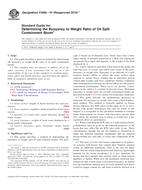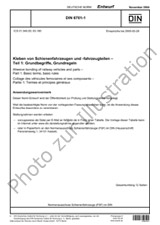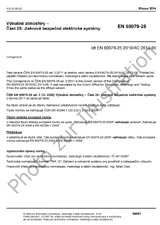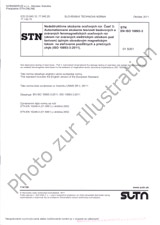Wir benötigen Ihre Einwilligung zur Verwendung der einzelnen Daten, damit Sie unter anderem Informationen zu Ihren Interessen einsehen können. Klicken Sie auf "OK", um Ihre Zustimmung zu erteilen.
ASTM F2682-07(2012)e1
Standard Guide for Determining the Buoyancy to Weight Ratio of Oil Spill Containment Boom (Includes all amendments And changes 5/16/2018).
Automatische name übersetzung:
Standard-Leitfaden zur Bestimmung des Auftriebs-Gewichtsverhältnis von Ölpest Ölsperre
NORM herausgegeben am 1.6.2012
Informationen über die Norm:
Bezeichnung normen: ASTM F2682-07(2012)e1
Anmerkung: UNGÜLTIG
Ausgabedatum normen: 1.6.2012
SKU: NS-54367
Zahl der Seiten: 3
Gewicht ca.: 9 g (0.02 Pfund)
Land: Amerikanische technische Norm
Kategorie: Technische Normen ASTM
Kategorie - ähnliche Normen:
Die Annotation des Normtextes ASTM F2682-07(2012)e1 :
Keywords:
boom, buoyancy, oil spill control equipment, oil spill response, spill containment, ICS Number Code 13.060.99 (Other standards related to water quality)
Ergänzende Informationen
| Significance and Use | ||||
|
This guide describes a method of determining the buoyancy to weight ratio of spill response booms. The principle is based on Archimedes Law, which states that a body either wholly or partially immersed in a fluid will experience an upward force equal and opposite to the weight of the fluid displaced by it. Unless otherwise specified, when used in this guide, the term buoyancy to weight ratio (B/W ratio) refers to the gross buoyancy to weight ratio. Buoyancy is an indicator of a spill response boom’s ability to follow the water surface when exposed to current forces, fouling due to microbial growth (which adds weight), and wave conditions. Surface conditions other than quiescent will have an adverse effect on collection or containment performance. When waves are present, conformance to the surface is essential to prevent losses. Minimum buoyancy to weight ratios for oil spill containment booms are specified in Guide F1523 for various environmental conditions. This guide provides the methodology necessary to determine the buoyancy to weight ratio using a fluid displacement method. This method is typically applied to booms having relatively low B/W ratios (in the range of 2:1 to 10:1). Booms with greater buoyancies may also be tested in this manner. It is acceptable to use calculation methods to estimate boom displacement for booms with buoyancies greater than 10:1, where the potential error in doing so would have a less significant effect on performance. When evaluating the B/W ratio of a spill response boom, consideration must be given to the inherent properties of the boom that may affect the net B/W ratio while in use. These considerations include, but are not limited to, absorption of fluids into flotation materials, membranes that are abraded during normal use, and entry of water into components of the boom. The entry of water into boom components is of particular concern with booms that contain their flotation element within an additional membrane. (This is the case for many booms that use rolled-foam flotation and relatively lightweight material for the boom membrane.) It is also important for booms that have pockets that enclose cable or chain tension members or ballast. When new, the membrane enclosure may contain air that would result in increased buoyancy. In normal use, the membrane material may be easily abraded such that it would no longer contain air, and water would be allowed in at abrasion locations. For such booms, the membrane enclosure shall not be considered as part of the flotation of the boom, and the membrane shall be intentionally punctured to allow water to enter during the test procedure. |
||||
| 1. Scope | ||||
|
1.1 This guide describes a practical method for determining the buoyancy to weight (B/W) ratio of oil spill containment booms. 1.2 This standard does not purport to address all of the safety concerns, if any, associated with its use. It is the responsibility of the user of this standard to establish appropriate safety and health practices and determine the applicability of regulatory limitations prior to use. |
||||
| 2. Referenced Documents | ||||
|
Ähnliche Normen:
1.5.2013
1.2.2005
1.10.2003
UNGÜLTIG
1.10.2014
UNGÜLTIG
1.10.2014
1.3.1991
Empfehlungen:
Aktualisierung der technischen Normen
Wollen Sie sich sicher sein, dass Sie nur die gültigen technischen Normen verwenden?
Wir bieten Ihnen eine Lösung, die Ihnen eine Monatsübersicht über die Aktualität der von Ihnen angewandten Normen sicher stellt.
Brauchen Sie mehr Informationen? Sehen Sie sich diese Seite an.



 DIN EN 60734:2013-05..
DIN EN 60734:2013-05.. E DIN 1999-100:2014-..
E DIN 1999-100:2014-.. STN 757360
STN 757360
 Cookies
Cookies
